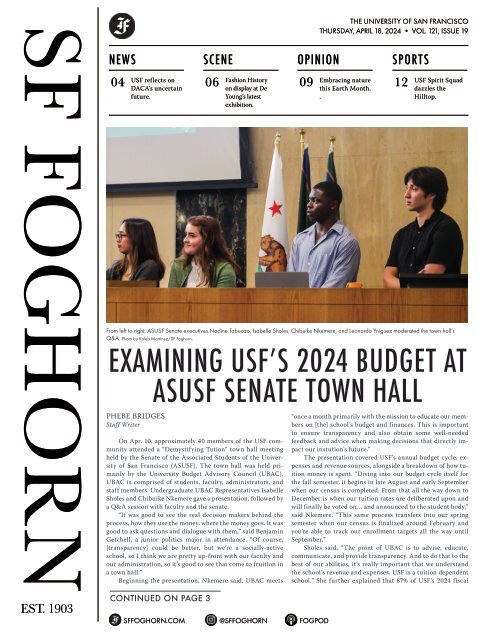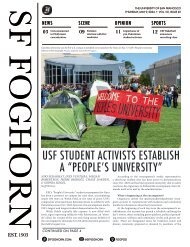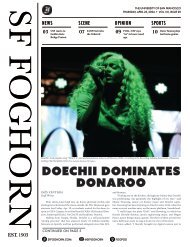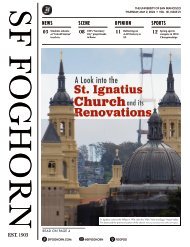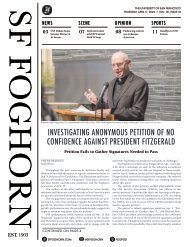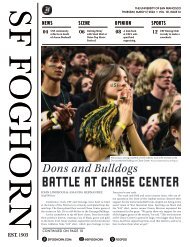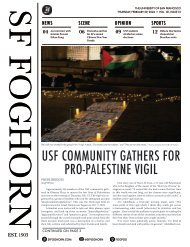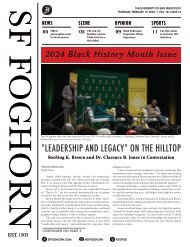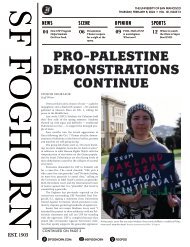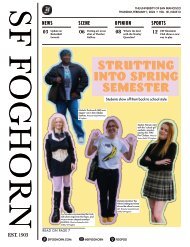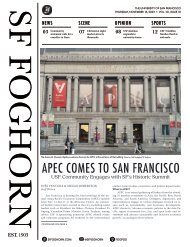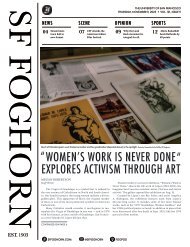Create successful ePaper yourself
Turn your PDF publications into a flip-book with our unique Google optimized e-Paper software.
SF FOGHORN<br />
EST. <strong>19</strong>03<br />
NEWS<br />
04<br />
USF reflects on<br />
DACA’s uncertain<br />
future.<br />
PHEBE BRIDGES<br />
Staff Writer<br />
On Apr. 10, approximately 40 members of the USF community<br />
attended a “Demystifying Tution” town hall meeting<br />
held by the Senate of the Associated Students of the University<br />
of San Francisco (ASUSF). The town hall was held primarily<br />
by the University Budget Advisory Council (UBAC).<br />
UBAC is comprised of students, faculty, administrators, and<br />
staff members. Undergraduate UBAC Representatives Isabelle<br />
Sholes and Chibuike Nkemere gave a presentation, followed by<br />
a Q&A session with faculty and the senate.<br />
“It was good to see the real decision makers behind the<br />
process, how they use the money, where the money goes. It was<br />
good to ask questions and dialogue with them,” said Benjamin<br />
Getchell, a junior politics major in attendance. “Of course,<br />
[transparency] could be better, but we’re a socially-active<br />
school, so I think we are pretty up-front with our faculty and<br />
our administration, so it’s good to see that come to fruition in<br />
a town hall.”<br />
Beginning the presentation, Nkemere said, UBAC meets<br />
CONTINUED ON PAGE 3<br />
SFFOGHORN.COM<br />
SCENE<br />
06<br />
Fashion History<br />
on display at De<br />
Young’s latest<br />
exhibition.<br />
@SFFOGHORN<br />
THE UNIVERSITY OF SAN FRANCISCO<br />
THURSDAY, APRIL 18, 2024 • VOL. 121, ISSUE <strong>19</strong><br />
OPINION<br />
09<br />
“once a month primarily with the mission to educate our members<br />
on [the] school’s budget and finances. This is important<br />
to ensure transparency and also obtain some well-needed<br />
feedback and advice when making decisions that directly impact<br />
our instution’s future.”<br />
The presentation covered USF’s annual budget cycle, expenses<br />
and revenue sources, alongside a breakdown of how tuition<br />
money is spent. “Diving into our budget cycle itself for<br />
the fall semester, it begins in late August and early September<br />
when our census is completed. From that all the way down to<br />
December is when our tuition rates are deliberated upon and<br />
will <strong>final</strong>ly be voted on… and announced to the student body,”<br />
said Nkemere. “This same process transfers into our spring<br />
semester when our census is <strong>final</strong>ized around February and<br />
you’re able to track our enrollment targets all the way until<br />
September.”<br />
Sholes said, “The point of UBAC is to advise, educate,<br />
communicate, and provide transparency. And to do that to the<br />
best of our abilities, it’s really important that we understand<br />
the school’s revenue and expenses. USF is a tuition dependent<br />
school.” She further explained that 87% of USF’s 2024 fiscal<br />
FOGPOD<br />
Embracing nature<br />
this Earth Month.<br />
.<br />
SPORTS<br />
12<br />
USF Spirit Squad<br />
dazzles the<br />
Hilltop.<br />
From left to right, ASUSF Senate executives Nadine Tabucao, Isabelle Sholes, Chibuike Nkemere, and Leonardo Yniguez moderated the town hall’s<br />
Q&A. Photo by Kaleb Martinez/SF Foghorn.<br />
EXAMINING USF’S 2024 BUDGET AT<br />
ASUSF SENATE TOWN HALL
02 03<br />
THURSDAY<br />
APR. 18<br />
2024<br />
SAN FRANCISCO<br />
FOGHORN<br />
Freedom and Fairness<br />
STAFF EDITORIAL<br />
CONTINUED FROM FRONT PAGE<br />
STAFF<br />
Editor in Chief<br />
MEGAN ROBERTSON<br />
mrrobertson2@dons.usfca.edu<br />
News Editor<br />
NIKI SEDAGHAT<br />
nisedaghat@dons.usfca.edu<br />
Opinion Editor<br />
CHISOM OKORAFOR<br />
cokorafor@dons.usfca.edu<br />
Scene Editor<br />
INÉS VENTURA<br />
ipventura@dons.usfca.edu<br />
Sports Editor<br />
CHASE DARDEN<br />
cbdarden@dons.usfca.edu<br />
Photography Editor<br />
SAMANTHA AVILA GRIFFIN<br />
svavilagriffin@dons.usfca.edu<br />
General Reporter<br />
PHEBE BRIDGES<br />
pjbridges@dons.usfca.edu<br />
General Reporter<br />
ELINA GRAHAM<br />
emgraham@dons.usfca.edu<br />
415.422.5444<br />
sffoghorn.com<br />
SUBMISSION POLICY<br />
The San Francisco Foghorn is the<br />
official student newspaper of the<br />
University of San Francisco and<br />
is sponsored by the Associated<br />
Students of the University of San<br />
Francisco (ASUSF).<br />
The thoughts and opinions<br />
expressed herein are those of the<br />
individual writers and do not<br />
necessarily reflect those of the<br />
Foghorn staff, the administration,<br />
the faculty, staff or the students of<br />
the University of San Francisco.<br />
Contents of each <strong>issue</strong> are the sole<br />
responsibilities of the editors.<br />
An All-American<br />
Publication<br />
ad maiorem dei<br />
gloriam<br />
The San Francisco Foghorn is free<br />
of charge.<br />
Advertising matter printed herein<br />
is solely for informational purposes.<br />
Such printing is not to be construed<br />
as written or implied sponsorship<br />
or endorsement of such commercial<br />
enterprises or ventures by the San<br />
Francisco Foghorn.<br />
©MMIV-MMV, San Francisco<br />
Foghorn. All rights reserved. No<br />
material printed herein may be reproduced<br />
without prior permission<br />
of the Editor in Chief.<br />
Managing Editor<br />
JORDAN PREMMER<br />
jepremmer@dons.usfca.edu<br />
Copy Editor<br />
SOPHIA SIEGEL<br />
scsiegel@dons.usfca.edu<br />
Layout Editor<br />
ANYA JORDAN<br />
arjordan@dons.usfca.edu<br />
Layout Editor<br />
HALLEY COMPUTESTO<br />
hmcompuesto@dons.usfca.edu<br />
Social Media Manager<br />
MARIA ZAIED<br />
mfzaied@dons.usfca.edu<br />
Online Editor<br />
ESHA DUPUGUNTLA<br />
ekdupuguntla@dons.usfca.edu<br />
ADVISOR<br />
TERESA MOORE<br />
2130 FULTON STREET, UC #417<br />
SAN FRANCISCO, CA 94117<br />
Columns for the Opinion section<br />
and Letters to the Editor are gladly<br />
accepted from students, faculty, staff<br />
and alumni.<br />
All materials must be signed and<br />
include your printed name, university<br />
status (class standing or title),<br />
address, and telephone number for<br />
verification. Anonymous submissions<br />
are not published.<br />
We reserve the right to edit materials<br />
submitted. All submissions<br />
become the property of the San<br />
Francisco Foghorn.<br />
Staff editorials are written by the<br />
Foghorn editorial staff and represent<br />
a group consensus.<br />
The San Francisco Foghorn Opinion<br />
page is a forum for the free, fair and<br />
civil exchange of ideas. Contributors’<br />
opinions are not meant to<br />
reflect the views of the Foghorn staff<br />
or the University of San Francisco.<br />
Students interested in contributing<br />
to the Foghorn can scan and fill out<br />
the QR code below.<br />
ECO-CIDE: HOW WAR WEAPONIZES THE ENVIRONMENT<br />
The environment has become<br />
a casualty of war. International law<br />
needs to catch up to this reality and<br />
address it.<br />
According to the World Economic<br />
Forum, ecocide means “unlawful or<br />
wanton acts committed with knowledge<br />
that there is a substantial likelihood<br />
of severe and either widespread<br />
or long-term damage to the environment<br />
being caused by those acts.” For<br />
example, companies dumping pollutants<br />
in waterways or cutting down<br />
entire forests would qualify.<br />
Though the word is relatively<br />
new, a handful of countries already<br />
consider it a crime. The Foghorn believes<br />
a more specific crime must be<br />
articulated: the crime of intentional<br />
and malicious destruction of land to<br />
render it uninhabitable for the population.<br />
In this way, the environment<br />
is leveraged as a weapon of warfare.<br />
For example, in Dec. 2023, the Israeli<br />
Defense Forces announced that<br />
they began pumping seawater into<br />
the tunnels under the Gaza strip. Beyond<br />
being a danger to any humans in<br />
those tunnels - such as Israelis being<br />
held by Hamas - an article by Scientific<br />
American details the potential<br />
environmental devastation of such an<br />
act. The seawater could contaminate<br />
the aquifer underneath Gaza, which<br />
the strip’s millions of residents rely<br />
for drinking, agriculture, and sanitization.<br />
United Nations (UN) experts<br />
warned the action could render the<br />
land uninhabitable. Furthermore,<br />
though Israeli officials claimed the<br />
move was to destroy Hamas’ militant<br />
capabilities, many argue the move<br />
is just another effort to ethnically<br />
cleanse Palestinians in Gaza from the<br />
land. If true, pumping seawater into<br />
Gaza’s grounds could be a violation of<br />
the UN’s Genocide Convention.<br />
A Human Rights Watch investigation<br />
in Oct. 2023 found that Israel<br />
also dropped white phosphorus on<br />
Gaza and parts of southern Lebanon<br />
— particularly agricultural areas.<br />
White phosphorus is an extremely incendiary<br />
chemical that ignites upon<br />
making contact with oxygen. When<br />
deployed, it is devastating to humans<br />
and nature alike. In Lebanon, white<br />
phosphorus scorched olive and citrus<br />
orchards to the ground and possibly<br />
have left the targeted land unusable<br />
for agriculture for years. This move<br />
violates the right of Lebanese people<br />
to an environment that can sustain<br />
them. Israel’s use of the chemical<br />
weapon has been decried as illegal<br />
under international norms.<br />
However, Israel is not the first<br />
country to weaponize the environment<br />
against their adversaries. There<br />
is a long history of forcing indigenous<br />
people off their lands via environmental<br />
destruction.<br />
In the <strong>19</strong>th century, the United<br />
States carried out a massacre of<br />
bison. This slaughter irreparably<br />
changed the landscape of the Great<br />
Plains east of the Rocky Mountains.<br />
Furthermore, South Dakota State<br />
University found that these killings<br />
were organized as a military strategy<br />
in the colonial project against the<br />
indigenous people to make their land<br />
uninhabitable.<br />
The environment was weaponized<br />
during the Civil War, with General<br />
William Sherman’s scorchedearth<br />
March to the Sea. It pops up in<br />
Vietnam, when U.S. troops deployed<br />
Agent Orange against rice farmland.<br />
The war crime of environmental<br />
destruction exists — we’ve seen<br />
it committed. Even so, international<br />
law hasn’t caught on. Though these<br />
acts clearly meet the conditions for<br />
Genocide under the Convention,<br />
which make it illegal to “Deliberately<br />
inflict… on the group conditions of<br />
life calculated to bring about its physical<br />
destruction in whole or in part,”<br />
we haven’t seen world leaders willing<br />
to vocalize this crime.<br />
Until we have the specific terminology<br />
to refer to the intentional weaponizing<br />
of the environment against<br />
its inhabitants, we are doomed to<br />
watch this crime be perpetrated over<br />
and over again.<br />
CORRECTIONS BOX<br />
In our Apr. 11 article, “USF Discontinues Tennis Programs,” we stated<br />
that the email announcing the program’s termination was sent to USF<br />
community members on Apr. 9. It was sent on Apr. 5.<br />
earth month spotlight<br />
BREAKING DOWN THE BUDGET<br />
revenue comes from tuition, a statistic which is<br />
provided by UBAC in their presentation, hyperlinked<br />
in the online edition of this article. Making<br />
up the rest of the budget, 8% is from auxiliary<br />
revenue, 2.2% is meal plan revenue, 1.2% is investment<br />
returns, .7% revenue is from fees, .5% is other<br />
revenue, and .3% is from gifts and contributions.<br />
“Auxiliary revenue includes things like room and<br />
board, as well as Koret,” specified Sholes. Also<br />
noted is the approximate $50 million received as<br />
restricted gifts, wherein the donors require their<br />
donations to go to a specific cause. Most frequently,<br />
this money goes towards scholarships and endowments.<br />
The total revenue for the 2024 fiscal<br />
year is $5<strong>19</strong>.8 million.<br />
Nkemere said, “Almost 100% of our school’s<br />
revenue is spent with the exception of about 3% in<br />
savings reserves.” According to the presentation,<br />
USF has $5<strong>19</strong>.8 million in total expenses for this<br />
2024 fiscal year.<br />
27% of the revenue is spent on academic affairs.<br />
“This is to pay salary for staff for those specific<br />
colleges themselves,” said Nkemere.<br />
courtesy of UBAC.<br />
35.8% of this revenue is spent on “other academic<br />
affairs.” “The other category is basically<br />
classified by all the money that’s spent that’s not directly in the academic<br />
schools themselves,” said Nkemere. “So, something that would<br />
be encompassed in this portion itself would be about $135 million in<br />
scholarships paid to students for this fiscal year.”<br />
Additionally, according to the presentation, 15.1% of the operating<br />
expenses goes to business and finances, 6.8% goes to student life,<br />
4.9% goes to ITS, 3.7% goes to athletics, 2.7% goes to institutional<br />
support, 2% goes toward development, 1% goes to the Office of Marketing<br />
Communications, .6% goes to general council, and .3% goes to<br />
the President.<br />
The percentages provided for both the revenue and expenses respectively<br />
add up to 99.9%.<br />
Pictured above are the University’s 2024 expenses, which is all the money slated to be spent this fiscal year.<br />
Graphic courtesy of UBAC.<br />
Pictured above are the University’s 2024 revenue, which is all the money collected this fiscal year. Graphic<br />
After the presentation was complete, the ASUSF Senate opened<br />
the floor for student questions, which were answered by members of<br />
the senate, alongside some administrative members of UBAC and faculty<br />
members.<br />
Students and community members asked questions pertaining to<br />
the budget and financial plans for the university. Some students, however,<br />
found the answers to be somewhat underwhelming.<br />
“I think [the faculty members] answered the questions, but… they<br />
didn’t give any hard answers, and they didn’t really make any concrete<br />
assurances to the audience,” said Getchell. “But, walking out, I did<br />
feel much more confident in our school’s organization…It probably<br />
lowered my anxiety a little bit about raising tuition.”<br />
For the 2024-2025 school year, USF announced that tuition will<br />
be raised by 3.9%, or $2,250 according to the presentation.<br />
In regards to tuition increases, Sholes<br />
said,“UBAC does not have any <strong>final</strong> decision [on<br />
tuition increases]. When [UBAC members vote],<br />
their votes are recommendations that then go to<br />
the higher ups… and that’s when the <strong>final</strong> decision<br />
is made.”<br />
After the town hall, Sholes told the Foghorn,<br />
“it was definitely nerve wracking leading up to [the<br />
town hall] because we both wanted to do a good<br />
job. It’s a bit of a difficult situation… we’re students<br />
but we also play a role in UBAC. I think overall it<br />
went well, I think a lot of the questions were really<br />
great and very thoughtful.”<br />
She continued, saying “I was really happy with<br />
how open everything was. There’s just, overall,<br />
hope that this is something that can continue every<br />
year, which I think is really positive.”<br />
Editor-in-Chief: Megan Robertson, Chief Copy<br />
Editor: Sophia Siegel, Managing Editor: Jordan<br />
Premmer, News Editor: Niki Sedaghat<br />
NEWS
04 05<br />
THURSDAY<br />
APR. 18<br />
2024<br />
NEWS<br />
USF COMMUNITY REFLECTS ON POSSIBLE<br />
TERMINATION OF DACA<br />
TASNEEM LUKMANJEE<br />
Staff Writer<br />
Professor Bill Hing solemnly addressed a room of students on Apr.<br />
11, saying, “These are some uncertain times…I’m sorry that this is<br />
happening to you all.” His voice sounded tired as he ended his lecture,<br />
sponsored by Latine Undergraduate Network of Activists (LUNA), at<br />
USF Law’s Kendrick Hall, Moot Courtroom.<br />
During the talk, he discussed the possible termination of the<br />
Consideration of Deferred Action for Childhood Arrivals (DACA)<br />
program.<br />
DACA is an administrative relief program which was established<br />
in 2012 by former President Barack Obama, providing legal protections<br />
to undocumented people who were brought to the U.S. as children.<br />
According to the University of California, Berkeley’s Undocumented<br />
Student Program, DACA provides eligible immigrants with<br />
“protection from deportation and… a work permit.”<br />
Hing’s DACA lecture was a part of an “Undocuweek” series at<br />
USF, organized by LUNA, an advocacy organization on campus that<br />
promotes positive representation of Latine students at USF and creates<br />
a space for Latine community members. Undocuweek was a weeklong<br />
program where LUNA hosted various events from Apr. 8 to Apr.<br />
12, with the goal of education and humanizing undocumented immigrants.<br />
Events ranged from celebrations to workshops and Hing’s<br />
DACA lecture.<br />
Hing is the founding director of the Immigration and Deportation<br />
Defense Clinic at USF, which works to represent immigrant families<br />
and children, the majority of whom are seeking asylum. He also<br />
founded the Immigrant Legal Resource Center in San Francisco.<br />
According to the Migration Policy Institute, “There were 579,000<br />
active DACA holders” as of Mar. 2023. As of the last available data<br />
in 2022, 40% of these DACA recipients were enrolled in school, with<br />
the majority, 83%, working towards a bachelor’s degree or higher, as<br />
reported by the President’s Alliance on Higher Education and Immigration.<br />
In July 2021, Judge Andrew S. Hanen from the U.S. District Court<br />
for the Southern District of Texas ruled that DACA was unlawful, following<br />
requests from Alabama, Arkansas, Louisiana, Nebraska, South<br />
Carolina, West Virginia, Kansas and Mississippi, NBC reports. They<br />
argued that “only Congress has the authority to grant unauthorized<br />
immigrants federal benefits,” and since Obama enacted DACA, it<br />
made the program, “an illegal overreach of executive power,” the same<br />
article reports.<br />
Hanen’s ruling prohibited U.S. Citizenship and Immigration Services<br />
from accepting first-time, new DACA applications, a precedent<br />
which continues today. The department continues to accept DACA<br />
renewals for people who had already entered the program before the<br />
Texas ruling in 2021, however.<br />
Since 2021, President Joe Biden’s administration has fought this<br />
precedent, going back and forth to the Fifth Circuit Court of Appeals<br />
multiple times. It’s anticipated that the case will be heard by the Supreme<br />
Court in the fall. In the lecture, Hing mentioned that one of the<br />
biggest threats against DACA currently is the Supreme Court ratio of<br />
six conservative justices to three liberals. According to Data For Progress,<br />
in 2023, 63% of Republican voters opposed continuing DACA. It<br />
is likely, as Hing expressed, that the right-leaning nature of the court<br />
could lead to a permanent end to the DACA program.<br />
Camila Ayala Hurtado, the president of USF’s Supporting Immigrants<br />
and Refugees Club, said, “I find the potential termination of<br />
DACA deeply distressing…This is a serious human rights <strong>issue</strong> and<br />
would be a loss for the country as a whole, considering how our immigrant<br />
communities have meaningfully contributed to this country in<br />
a variety of ways.”<br />
Further, Hurtado said, “For many DACA recipients, the United<br />
States is the only home they have known. Thinking of these people<br />
being potentially deported to unfamiliar countries is both heartbreaking<br />
and unjust. There are no<br />
words to describe how this<br />
uncertainty is devastating<br />
and makes me lose hope for<br />
the future of our immigrant<br />
communities in this country.”<br />
Paulina Diaz-Mandujano,<br />
a student who attended<br />
the DACA lecture said, “I<br />
think it’s so cool that student<br />
organizations such as LUNA<br />
help arrange these events, especially<br />
in such scary times.”<br />
Hurtado said, “I want<br />
to believe that by standing<br />
in solidarity and advocating<br />
against DACA ending, we<br />
can prevent this and protect<br />
our communities.”<br />
The lecture invited DACA students to discuss “steps to take” in light of DACA’s possible termination, according to LUNA’s Instagram.<br />
Photo by Samantha Avila Griffin/SF Foghorn.<br />
LUNA hosts “Undocuweek” to support undocumented immigrants<br />
Editor-in-Chief: Megan<br />
Robertson, Chief Copy Editor:<br />
Sophia Siegel, Managing<br />
Editor: Jordan Premmer,<br />
News Editor: Niki Sedaghat<br />
PICTURING ARTS AND SCIENCE<br />
INÉS VENTURA<br />
Staff Writer<br />
Museum Studies students curate Gleeson Library exhibit<br />
Before USF museum studies students get to curate the Guggenheim<br />
or the Smithsonian, they get their curatorial beginnings here at<br />
the Gleeson Library.<br />
The 20 students of this semester’s museum studies class are currently<br />
putting together an exhibition titled “Knowledge Bound: The<br />
Union of Art and Science in Early Modern Printed Books.” The exhibit<br />
will be held at the Donahue Rare Book room on the third floor of the<br />
The illustration above comes from the “Study of Anatomy Through the History of Science” written by<br />
Andreas Vesalius, an anatomist and physician, circa 1514-1564 — The book is one of many to be<br />
displayed in the exhibition. According to Marcucci, the book was “critical to research studies in medical<br />
history during the early medieval era.” Photo courtesy of Gabreila Marcucci<br />
Gleeson Library, opening on Apr. 24 and on-display through the rest<br />
of the semester.<br />
Professor Catherine Luschek, chair of the Art + Architecture department<br />
and professor of the class, proposed the student curators<br />
with the idea of dissecting early modern art, which eventually evolved<br />
into the exhibit’s topic.<br />
“So I’ve been interested in the topic for a long time and been working<br />
with students on the topic for a long time, and so I wanted to kind<br />
of marry these interests of this incredible collection with these teaching<br />
interests,” Luschek said.<br />
The exhibit will showcase approximately 20 vintage<br />
books, spanning across different disciplines like<br />
geology, anatomy, botanicals, alchemy, astronomy and<br />
mathematics — considering science as a creative medium.<br />
Gabriela Marcucci, sophomore museum studies<br />
major, said “We [tried] to focus in on how scientific<br />
illustration guided early knowledge, and our understanding<br />
of the world — and how it creates a deeper<br />
understanding of what we know now.” She continued,<br />
“We’re kind of exploring the symbiotic relationships<br />
between text and image, and how it accelerates the<br />
speed of knowledge.”<br />
The students collaborated on every aspect of the<br />
exhibit–from coming up with the title, to conceptualizing<br />
themes, to creating promotional materials and<br />
labels for each of the displayed books. They also chose<br />
what pages of the books to display and decided on an<br />
orientation that best communicated the theme.<br />
Luschek continued, “So there’s the exhibition<br />
that’s open to the public, but on the teaching side,<br />
what I’m trying to do is teach what’s often called curatorial<br />
discrimination…Like how do you choose, how<br />
do you select, on what basis, how do you think about<br />
works in concert with each other, how do you create an<br />
exhibition that makes sense.”<br />
A challenge that students encountered throughout<br />
the curatorial process was only being able to show<br />
two pages of every book, so they had to get picky with<br />
selections. Micah Hart, student curator and sophomore<br />
art history major, said, “We began with probably<br />
more than double the objects that are currently in the<br />
show.”<br />
She continued, “Through this exhibition we are<br />
really trying to communicate the nuanced relationship<br />
art and science have had with one another… When<br />
putting these two modes of communication in discourse<br />
with one another you come up with something<br />
more complex and unique than you would get from the<br />
presence of just one medium.”<br />
When speaking on what the exhibit aims to<br />
achieve for viewers, Marcucci and her classmates want<br />
“students to see what the fundamentals of what their<br />
career and their studies are based on… Early history<br />
was so important for their careers and so important<br />
for understanding and knowledge.”<br />
“What we’re trying to tell them is that science and<br />
art are not different… They live in conjunction with<br />
each other,” said Marcucci.<br />
Editor-in-Chief: Megan Robertson, Chief Copy Editor:<br />
Sophia Siegel, Managing Editor: Jordan Premmer, Scene<br />
Editor: Inés Ventura<br />
SCENE
06 07<br />
THURSDAY<br />
APR. 18<br />
2024<br />
HAUTE COUTURE with a side of<br />
AUGMENTED REALITY<br />
A Century of San Francisco Style at the de Young<br />
earth month spotlight<br />
HIGH-END FASHION IS A HOAX!<br />
SCENE<br />
ELINA GRAHAM<br />
Staff Writer<br />
The recognizably dreamy notes of Glenn Miller’s “Moonlight Serenade”<br />
played as viewers gazed upon mannequins modeling a range of<br />
designs in the de Young museum’s latest exhibition, “Fashioning San<br />
Francisco: A Century of Style.”<br />
This exhibition explores the evolution of women’s fashion in San<br />
Francisco by highlighting legendary collections and designers of the<br />
20th and 21st centuries. According to their website, this is the museum’s<br />
“first major presentation of [their] costume collection in over 35<br />
years.” In addition to Christian Dior, Comme des Garçons and Vivienne<br />
Westwood, more than fifty designers’ works are on display — for<br />
many pieces, this is their first showing.<br />
“‘Fashioning San Francisco’ is a rich presentation that asserts the<br />
case that San Francisco does, and has always had, style,” stated Thomas<br />
P. Campbell, director and CEO of the Fine Arts Museums of San<br />
Francisco in a press release.<br />
The exhibit also collaborated with Snapchat’s parent company,<br />
Snap Inc., to invite viewers to use augmented reality (AR) to see themselves<br />
in this historical legacy.<br />
Greeting visitors as they entered the room, a<br />
mannequin was dressed in Jeanne Lanvin’s “Veilleur<br />
de Nuit” evening gown of the Spring/Summer<br />
<strong>19</strong>24 collection. With a dropped waist and a full,<br />
calf-hitting skirt evocative of the 18th century,<br />
this hundred-year-old “robe de style” has a<br />
silhouette Lanvin popularized in the<br />
<strong>19</strong>20s.<br />
Further down the narrow<br />
halls of the exhibit is a room devoted<br />
entirely to shoes. From the<br />
<strong>19</strong>98 patent Prada Mary Janes,<br />
to Rei Kawakubo’s embroidered<br />
leather “Cut Out Cowboy” design<br />
from the <strong>19</strong>99 Fall/Winter<br />
collection, many styles have once<br />
graced the streets of San Francisco.<br />
The main exhibition wing featured<br />
styles ranging from experimental clothing<br />
to suitwear, including Richard<br />
Tam’s ostrich-feather headdress, mask<br />
and fan that accompanied a printed<br />
paisley silk Valentino evening gown,<br />
and a honeycomb inspired jacket<br />
designed by Junya Watanabe for<br />
Comme des Garçons in 2015.<br />
Many of these pieces<br />
were gifted to the museum<br />
by San Francisco<br />
philanthropists<br />
and fashionistas.<br />
Christine Suppes,<br />
author and founder of digital couture publication Fashionlines,<br />
donated more than 500 articles of clothing to the museum. Suppes<br />
wore many of the ensembles to black-tie galas and balls.<br />
“‘Junon’ and ‘Venus’, the two Dior ball gowns, stood out to me for<br />
sure,” said junior media studies student Alley Garland, whose interest<br />
in high fashion brought her to the exhibition. “They were absolutely<br />
stunning and it was incredible to look at all of the beading and detail<br />
gone into every part of each dress.” These pieces were found in the<br />
formalwear section, among other couture gowns by the likes of John<br />
Galliano for Christian Dior and Karl Lagerfeld for Chanel.<br />
Outside of the main showing room was a wing dedicated to the<br />
“Little Black Dress” design, known in the fashion world as a staple in<br />
a woman’s wardrobe. The term now suits a range of styles, as seen by<br />
the distinctive and unique dresses on display, including the black silk<br />
velvet “Soirée de Paris” gown designed by Yves Saint Laurent while he<br />
worked for Christian Dior. This gown was available to virtually try on<br />
in the exhibit’s special augmented reality (AR) room post-exhibition<br />
viewing.<br />
Similar to how Snapchat filters work, a viewer could stand in<br />
front of one of three mirrors and virtually try on three iconic designs<br />
by Yves Saint Laurent, Kaisik Wong and Valentino. The real works<br />
were all on display upstairs, but this installation gave museum-goers<br />
the opportunity to snap a photo in a designer gown.<br />
Junior media studies student Ella Brohm said<br />
“I thought the [AR] was kind of a weird addition.”<br />
On the other hand, Garland enjoyed the installation.<br />
“The AR experience was so fun! It was a little silly<br />
but my sister and I laughed the whole time and took<br />
a bunch of photos,” she said.“ I thought it was nicely<br />
done and it actually looked like we were wearing<br />
the clothing. It’s definitely the closest I’ll ever<br />
get to wearing haute couture.”<br />
“I hope visitors see the impact that women’s<br />
fashion has had on society,” Garland continued.<br />
“You can see the evolution of fashion<br />
simply through the complexity, form and use<br />
of color in them. Fashion is a huge part of expression<br />
and these designers capture a wide<br />
range of femininity that is really neat.”<br />
Fashioning San Francisco: A Century<br />
of Style is on display at the de Young<br />
museum through August 11. Tickets<br />
can be purchased on the museum’s<br />
website, students can get a discounted<br />
ticket with valid student ID.<br />
Editor-in-Chief: Megan<br />
Robertson, Chief Copy Editor:<br />
Sophia Siegel, Managing Editor:<br />
Jordan Premmer, Scene<br />
Editor: Inés Ventura<br />
While the exhibit is centered around historical fashion, it also showcased more contemporary pieces, like Edwin Oudshoorn’s Spring/Summer 2020 Spellbound gown with<br />
detached sleeves and pin. Photo by Samantha Elina Graham/SF Foghorn<br />
According to the SF Museum of Fine Arts’ Textile and Conservation Lab, each of the tens of thousands of sequins seen on the Dior “Venus” gown (seen above) are individually<br />
swabbed as part of their conservation practice. Photo by Samantha Elina Graham/SF Foghorn<br />
REMI BRANDLI is a junior<br />
media studies major.<br />
High-end fashion brands are<br />
aligning themselves with social<br />
movements to attract larger audiences,<br />
yet their output is insulting to the<br />
communities they are supposedly<br />
representing. While major brands<br />
receive attention and money, true<br />
activists fight for a level playing field.<br />
We as consumers must divert<br />
our attention and money from<br />
corporations that are: reinforcing<br />
racist tropes, destroying the<br />
environment, and doing so all<br />
the while claiming to be forwardthinking.<br />
RACIST TROPES<br />
According to brand executives<br />
themselves, Banana Republic was<br />
initially created as an imagined, exotic place, “like Shangri-La, Middle<br />
Earth, Westeros, or Wakanda,” as stated in their 2021 rebrand campaign.<br />
The inspirations and descriptors of the new fashion line included<br />
aesthetics such as “safari meets tuxedo,” according to the brand. Even<br />
Banana Republic’s name is rooted in the colonization of Latin American<br />
and African countries according to Fast Company. The fetishized appeal<br />
of the “safari” seeps from the dark history of imperialism into the modern<br />
day.<br />
In their 2024 advertising, you will find only two Black models and<br />
two Asian models sandwiched between their five white counterparts—a<br />
lacking attempt at promoting racial diversity. Companies are utilizing<br />
these models merely to place them in an imagined exotic world, tokenizing<br />
them based on their race.<br />
It extends beyond Banana Republic. De Beers Jewellers tokenized<br />
Lupita Nyong’o, a Mexican-Kenyan actor, as a model for their “Where it<br />
Begins” campaign. The name of said campaign is “a visual nod to De Beers’s<br />
South African origins … and ongoing mining activities in Botswana,<br />
Namibia, and South Africa,” states Nancy Friedman in an article exploring<br />
the company’s history. Notably, none of those countries are Kenya.<br />
LACK OF TRANSPARENCY<br />
The De Beers Diamond Co. and Marc Jacobs neglect to<br />
consistently update their codes of ethics in terms of resource<br />
extraction. Both companies follow the UK Modern Slavery Act,<br />
as posted on their websites under their codes of ethics. The 2015<br />
legislation aims to make provisions “about slavery, servitude and<br />
forced or compulsory human labour and about human trafficking,”<br />
according to the bill.<br />
While adhering to this legislation is admirable, it is not enough<br />
to claim compliance and then not consistently update consumers<br />
on ethical sourcing of materials in areas known to exploit laborers.<br />
Recent updates regarding these brands’ ethics are not available. De<br />
Beers’ last statement was in 2022, and Marc Jacobs’ was in 2018.<br />
ENVIRONMENTAL IMPACT<br />
While sustainability in fashion can be possible, current<br />
industry business models are resistant to it. The industry’s lack of<br />
transparency makes assessing sustainability difficult. According to<br />
the Harvard Business Review of unsustainable fashion practices,<br />
most corporate social responsibility reports “do not accurately<br />
quantify the full carbon emissions profile of fashion brands.”<br />
Further, attempts at sustainable fashion have struggled in the<br />
existing business models which prioritize rapid-consumerism..<br />
The McKinsey Global Fashion Index has tracked “a burst<br />
of pent-up consumer demand,” boosting global industry revenues up<br />
between 6-21% in the years 2021 and 2022. This boost is paralleled by<br />
the rise in the fashion industry’s “carbon impact range” by 6%, according<br />
to the Harvard Business Review. While corporations continue to prosper,<br />
our planet is dying in the name of trends.<br />
DIVESTMENT<br />
We must boycott brands that preach values of transparency they do<br />
not practice, brands that exoticize and fetishize models as representation<br />
and diversity, and brands that put money towards the oppression of other<br />
humans. Luckily there are tools to help us with this.<br />
One of my go-to models for sustainable consumerism is Nabihah<br />
Ahmad. A student at Columbia University, Ahmad is a “Bangladeshi-<br />
Muslim American from Queens, NY,” as described in her Instagram post.<br />
Her startup, SSQRD, is focused on remodeling modern fashion and hosts<br />
the website Ethos, which filters for ethical brands and products.<br />
Functioning under values of transparency and community, the<br />
startup is “a movement aimed at breaking down the barriers created by<br />
traditional corporations,” according to the Ethos website. Ahmad comes<br />
from a family of garment workers in Bangladesh, and is motivated to<br />
create change on behalf of her family.<br />
With a wide list of fashion, skincare, makeup and fragrances, many<br />
products are tagged as “Black-owned,” “Palestinian owned,” or other<br />
notable identifiers, encouraging consumers to support sustainable<br />
businesses and marginalized business owners.<br />
There is an added layer of transparency with the “Caution” label,<br />
identifying products and brands with problematic elements, such as alleged<br />
forced labor practices and fiscal support of Israel. Ethical consumption<br />
of fashion and beauty is possible, by supporting transparent, ethical<br />
brands and entrepreneurs. Ahmad is just one example of fashion moguls<br />
whose values align with the greater community. SSQRD is a great way to<br />
promote and support brands and businesses that operate on humanitarian<br />
principles, not just profit.<br />
Editor-in-Chief: Megan Robertson, Chief Copy Editor: Sophia<br />
Siegel, Managing Editor: Jordan Premmer, Opinion Editor: Chisom<br />
Okorafor<br />
Graphic by Mariam Diakite/Graphics center<br />
OPINION
08 09<br />
THURSDAY<br />
APR. 18<br />
2024<br />
e a r t h m o n t h s p o t l i g h t<br />
POLL: ARE ENVIRONMENTAL PLANT-BASED DIETS ENOUGH?<br />
THE MYTH OF WILDERNESS<br />
OPINION<br />
ELINA GRAHAM is a junior<br />
media studies major.<br />
Plant-based diets, such as<br />
veganism and vegetarianism are often<br />
recommended as environmentally<br />
sustainable alternatives to typical<br />
meat-centric options. Undoubtedly,<br />
a plant-based diet is better for the<br />
planet as fewer natural resources are<br />
needed and less greenhouse gasses<br />
are emitted in the production of these<br />
foods compared to meat products.<br />
Championing all-green diets<br />
is not necessarily the cure for all<br />
environmental problems. Not only<br />
does it put pressure on individuals,<br />
rather than institutions, to save the<br />
world through lifestyle choices, the<br />
production of some plant-based<br />
foods has led to major resource<br />
exploitation and unethical labor<br />
practices. Before making the switch, or policing others for choosing to<br />
eat meat, one needs to do research to analyze how sustainable plantbased<br />
diets really are.<br />
While everyone has a role to play in sustainability, one person’s<br />
choice to eat a steak in no way compares to the destruction that major<br />
corporations like Exxon and Chevron inflict on the planet. Research<br />
from Dr. Peter Frumhoff at the Union of Concerned Scientists finds<br />
that “CO2 and methane emissions from the 90 biggest industrial<br />
carbon producers were responsible for almost half the rise in global<br />
temperature and close to a third of the sea level rise between 1880<br />
and 2010.” When we put energy into targeting individuals for their<br />
diets rather than holding these fossil fuel giants accountable, it’s not<br />
productive for anyone.<br />
That’s not to say that the meat industry doesn’t put a big strain on<br />
the environment. Animals like cows and sheep emit large amounts of<br />
methane and nitrous oxide. According to the Environmental Protection<br />
Agency, “a single cow produces between 154 to 264 pounds of methane<br />
gas per year.” Additionally, clearing land for grazing purposes causes<br />
massive deforestation. An estimate from the World Research Institute<br />
in 2021 shows that cattle ranching is responsible for the destruction of<br />
16% of world forests between 2001 and 2015.<br />
An article by the Associated Press reveals that “if half of U.S.<br />
animal-based food was replaced with plant-based substitutes by 2030,<br />
Q: Do you believe going vegan/vegetarian<br />
is better for the environment?<br />
Yes<br />
26%<br />
Somewhat<br />
37%<br />
No<br />
37%<br />
Graphic by Halley Compuesto/SF Foghorn<br />
the reduction in<br />
emissions for that<br />
year would be<br />
the equivalent of<br />
taking 47.5 million<br />
vehicles off the<br />
road.” Overall,<br />
plant-based<br />
food production<br />
requires less water,<br />
land and generates<br />
fewer greenhouse<br />
gasses than meat<br />
counterparts.<br />
B e t w e e n<br />
2018 and 2021<br />
there was a surge<br />
Graphic by Zoë Carr/Graphics center<br />
in popularity for plant-based meat substitutes, with an estimated 79<br />
million U.S. households consuming meat alternatives in 2021, according<br />
to the Plant-Based Foods Association.<br />
The spike in popularity for meatless meat was an optimistic sign.<br />
Unfortunately, the hype died down quickly, and sales of plant-based<br />
meat have not been advancing enough to cause a serious change to<br />
the planet. Environmental scientist David Lobell noted that in terms<br />
of reducing climate change, plant-based meat “won’t be fast enough to<br />
come close to solving the food emissions problem by itself.”<br />
On top of the slow progress that plant-based meats are making,<br />
solving climate change is not as simple as replacing steaks with salads<br />
when one takes into account the toll that growing and transporting<br />
produce takes on the environment.<br />
For example, Mexico is the world’s top avocado supplier and<br />
producer. Reports from Climate Rights International show that their<br />
avocado production has led to deforestation and illegal extraction of<br />
water for irrigation, which contributes to water shortages for residents.<br />
Embracing a fully plant-based diet won’t help the planet if the plants in<br />
question also hold potential for destruction to the environment.<br />
To get a sense of USF’s thoughts on the effectiveness of cutting<br />
out meat for environmental purposes, the Foghorn conducted a poll<br />
on Fizz, an anonymous college campus social media app, where users<br />
must have a “@dons.usfca.edu” email address to become a member. The<br />
Foghorn asked, “Do you believe going vegan/vegetarian is better for the<br />
environment?” The poll received 1,263 votes; “No” received 37% (469<br />
votes), tying with “Somewhat”, which also received 37% (462 votes).<br />
“Yes” received 26% (332 votes).<br />
One user “refizzed” the poll with the comment, “Yeah but I’m not<br />
finna stop eating in and out cheeseburgers,” a sentiment that many poll<br />
participants agreed with.<br />
Research shows that gas emissions from livestock will continue to<br />
increase. I believe that while doing what we can as individuals will help,<br />
we need radical changes from giant corporations if we’re ever going<br />
to combat climate change. It will take more than just a few swapped<br />
cheeseburgers to reduce the world’s rising temperatures.<br />
Editor-in-Chief: Megan Robertson, Chief Copy Editor: Sophia Siegel,<br />
Managing Editor: Jordan Premmer, Opinion Editor: Chisom Okorafor<br />
IZY WELL is a sophomore<br />
environmental studies major.<br />
What do you think of when you<br />
think of the word “nature?” How about<br />
“wilderness?” While in American<br />
culture, many people use wilderness<br />
and nature interchangeably, I argue<br />
that they are two separate concepts.<br />
Wilderness is a human-created<br />
concept based on the exploitation of<br />
Indigenous peoples and their land,<br />
while nature can act as a form of<br />
resistance against this. Nature can<br />
be anything you want it to be and is<br />
about the way you interact with the<br />
world around you.<br />
According to the New York Times,<br />
the concept of “wilderness,” for many,<br />
brings to mind a utopia untouched<br />
by modern society characterized<br />
by wide-open canyons, savage animals, rugged-individualism and most<br />
notably the absence of other people. According to the same article, many<br />
Americans see national parks as the last remaining wilderness in the<br />
United States.<br />
A common belief is that one must get out into the “wilderness” in order<br />
to find their “true self,” which has created associations of high morality<br />
with those who spend time in wilderness, and can intimidate those who<br />
have little outdoor experience. This has been capitalized on by advertisers<br />
and travel agencies selling wilderness as an aesthetic through the vehicle<br />
of $200 Cotopaxi backpacks or a white water rafting excursion. In my own<br />
life, friends continually re-tell their stories from hiking the Pacific Crest<br />
Trail, increasing the mileage with each narrative.<br />
These ideas perpetuate a misconception about how we need to “get<br />
out” into nature and can undermine the importance of the nature in our<br />
city that we coexist with every day.<br />
Wilderness is often presented as more “pure” than other areas, but<br />
the truth is that wilderness is a myth. Wilderness is not natural at all, but<br />
a product of the human mind and the hierarchies that it creates.<br />
Indigenous peoples have long inhabited and stewarded these lands<br />
considered wild. They hold deep spiritual and cultural connections to the<br />
land. Many of the areas we think of as “wild” are actually the carefully<br />
cultivated product of centuries of work. For example, California’s<br />
Redwood forests thrive in an interactive relationship with their<br />
indigenous residents, who practice “prescribed burns.” This is the practice<br />
of intentionally setting fires to prevent and mitigate larger disasters.<br />
According to National Geographic, controlled burns not only help prevent<br />
wildfires through ridding the forest of dead leaves and logs that can act<br />
as kindling for wildfires, but can also promote growth of young trees as<br />
space is opened up, letting more light into the understory. Historically, the<br />
National Parks Service has had strict anti-fire policies based on the idea of<br />
conservation, which actually decreased forest health.<br />
Like many other American institutions, wilderness is extremely<br />
reductive to Indigenous peoples experiences and perpetuates a separation<br />
between humans and the natural world — a practice which is antithetical<br />
to the cultural beliefs of many indigenous groups.<br />
Post-colonization President Woodrow Wilson instituted a National<br />
Parks system in <strong>19</strong>16 , with the intention of preserving “untouched<br />
wilderness.”<br />
Presenting wildlife preserves as “natural” is simply a facade, as these<br />
lands and their Indigenous people’s had to experience genocide and violent<br />
removal before they were able to be called Yosemite or Yellowstone.<br />
Focusing on the myth that wilderness is the only vehicle for connection<br />
with the natural world further perpetuates the separation between<br />
humans and nature.<br />
Enjoying nature does not have to mean traveling to far-away places<br />
which require resources and training to enjoy safely, but is more about<br />
cultivating a mutually beneficial relationship with the natural world<br />
around you. It is important to make an effort to disconnect the concepts<br />
of nature and wilderness in your mind. Nature, and how you interact with<br />
it, can be anything you want it to be.<br />
While I will continue to visit national parks and appreciate their<br />
educational capacities and stunning biodiversity, spending time in nature<br />
can also mean sitting in the sun on your roof, taking a walk through your<br />
local park or sitting outside to eat lunch. It can be as simple as keeping<br />
the streets of our city litter-free, or reducing your personal plastic and<br />
petroleum consumption.<br />
This Earth Month, I invite you to commune with the world beyond<br />
you in whatever way makes you feel present, while keeping in mind<br />
your connection to the world around you and how you can keep your<br />
relationship with nature reciprocal. I encourage you to treat the nature in<br />
our city with the same reverence and excitement that is given to national<br />
parks, and spend some time in San Francisco’s greenspaces!<br />
Editor-in-Chief: Megan Robertson, Chief Copy Editor: Sophia<br />
Siegel, Managing Editor: Jordan Premmer, Opinion Editor: Chisom<br />
Okorafor<br />
Graphic by Zoë Carr/Graphics center<br />
OPINION
10 11<br />
THURSDAY<br />
APR. 18<br />
2024<br />
SPORTS<br />
JOHN LINDROOS<br />
Staff Writer<br />
A 7,000 MILE JOURNEY<br />
Cyprus native and defensive midfielder Alex Solomis is no stranger<br />
to holding himself to a high standard. The first-year student-athlete<br />
lives and breathes soccer, and views the opportunity of playing for the<br />
USF soccer team as a stepping stone to reaching his goal.<br />
“I always say, whatever the case, I’m gonna go pro. I just want to<br />
make it, anywhere I can just play [soccer],” Solomis said. “Right now,<br />
the ultimate goal I would say is the MLS [Major League Soccer].”<br />
Solomis was born on the small island of Cyprus, which is located<br />
in the eastern region of the Mediterranean Sea. He grew up in the capital<br />
city of Nicosia, which is known for its warm climate throughout the<br />
majority of the year, with temperatures peaking around 110 degrees in<br />
the summer. In his free time, Solomis said he enjoys going to the beach<br />
Alex Solomis is chasing his dream of becoming a professional soccer player. Photo courtesy of Chris M.<br />
Leung/Dons Athletics<br />
Alex Solomis Thrives on the Pitch<br />
and spending time with his family.<br />
After being introduced to soccer at the age of four, Solomis quickly<br />
fell in love with the game. “I feel like it’s the best sport because it<br />
requires so much thinking,” he said. “It requires everything. You have<br />
to be smart. You have to be fast. You have to be technical. You have to<br />
be focused for more than 90 minutes.”<br />
Throughout his time in Cyprus, Solomis trained with the U17 and<br />
U<strong>19</strong> National Team during the 2018-<strong>19</strong> and 2020-21 seasons, and he<br />
won the U<strong>19</strong> First Division Championship with Omonoia FC in 2022.<br />
From his experience, Solomis pointed out the strong sense of community<br />
he felt due to Cyprus’ small size. “Everyone knows you and you<br />
know them. I knew most of the kids I was playing with,” he said. “The<br />
teams weren’t many. For my team, there were many players that were<br />
on the national team as well.”<br />
Transitioning from his native country to a city that he considers<br />
“very hectic,” Solomis said that it took some time<br />
for him to get comfortable in San Francisco. “I went<br />
from one of the most laid-back places to one of the<br />
craziest places,” he said. “In the beginning, it was<br />
pretty hard. It was difficult to adjust. It also affected<br />
the way I was playing, it took me a while to really<br />
start giving what I know I can do.”<br />
Solomis added that the difference in playstyle<br />
between European and American soccer also contributed<br />
to his adjustment. “Europe is a lot more<br />
technical. [America], it’s a lot more physical,” he<br />
said. “The pace of the game is faster. You don’t have<br />
a lot of space and time to react to make a pass or to<br />
transition from defense.”<br />
Teammate Kaleb Afsari said, “His skill lies in<br />
his knowledge for the game as well as his technical<br />
ability. He has great technique in long passes, shooting,<br />
and control.”<br />
His passion is apparent to those who play with<br />
him. USF teammate and fellow Cyprus native Constantinos<br />
Michaelides, said, “Alex is a very determined,<br />
hardworking individual. His work ethic is<br />
something that drives and gives energy to those who<br />
find themselves around him.”<br />
When Solomis isn’t physically training, he turns<br />
his attention to watching professional soccer games,<br />
where he tries to learn from the best. “I model my<br />
game after Sergio Busquets, a defensive midfielder<br />
from Barcelona. I have similar traits to him. He’s a<br />
lot more technical and has really good vision, composure,<br />
and passing range,” Solomis said.<br />
When playing on the field, Cyprus is on his<br />
mind. Even 7,000 miles away from home, he said,“I<br />
feel more passionate about representing my country<br />
now that I’m away from it because I also miss home<br />
a lot.”<br />
To others with big dreams, Solomis said, “If<br />
you’re passionate about something, commit to that<br />
and give everything to that. Don’t do something just<br />
to do it. Don’t just get a degree to get a degree. Do<br />
something you actually love doing and want to have<br />
a future with.”<br />
Editor-in-Chief: Megan Robertson, Chief Copy Editor:<br />
Sophia Siegel, Managing Editor: Jordan Premmer,<br />
Sports Editor: Chase Darden<br />
FROM THE DESK TO THE DIAMOND<br />
AMANDA HERNANDEZ<br />
Staff Writer<br />
Joe Soberon Balances Law School and Baseball<br />
Joe Soberon, the starting pitcher of the Dons Men’s<br />
Baseball team has surpassed the conventional role of a<br />
student-athlete, balancing law school and his athletic<br />
career.<br />
Soberon’s dedication to baseball began at the age of<br />
five when he started playing tee-ball. He has since spent<br />
countless hours dedicated to travel baseball, high school<br />
ball, and college ball.<br />
The start of his college career began at the University<br />
of California, San Diego (UCSD) in 2020. The summer<br />
prior to his first semester at UCSD, he tore his ACL and<br />
had to spend his entire first year of baseball red-shirted<br />
so that he could recover.<br />
Despite being faced with such challenges, he found<br />
that red-shirting for a year allowed him to move forward<br />
with his educational journey. This led him to successfully<br />
complete his bachelor’s degree in sociology with a<br />
minor in political science in three years.<br />
Though Soberon still had two years of eligibility<br />
left after graduation, he wasn’t sure what the next steps<br />
would be for him. He considered giving up baseball and<br />
focusing primarily on graduate school.<br />
However, he had been in contact with many different<br />
schools interested in pursuing him, but USF seemed<br />
to fit.<br />
“The coaches said, ‘why not start law school now instead<br />
of waiting until after I am done with baseball’ and<br />
I think that was pretty cool,” said Soberon. “It was a sign<br />
from them that they really wanted me to be here, so they<br />
were trying to find ways for me to get something outside<br />
of just playing more ball.”<br />
As he began a new part of his academic and athletic<br />
career at USF last fall, he realized how seamlessly he fit<br />
in with the team who quickly became his friends. This<br />
provided him with a sense of community that made his<br />
transition from UCSD to USF much easier.<br />
As a full-time law student and baseball player, Soberon<br />
seeks to find balance in his day to day life. He<br />
manages the dual demands by relying on the support of<br />
his coaches and teammates<br />
“My teammates here have been really accommodating.<br />
It’s hard, I make it to half the practices and all the<br />
games, so I am there for the hardest part with the guys,<br />
mentally. They have been really good to me in terms of<br />
trusting that I am taking care of business, and I’m not slacking off. It is<br />
a really cool group of guys.” said Soberon.<br />
Soberon recently earned the Rawlings West Coast Conference<br />
Pitcher of the Week honor and finds himself needing to prioritize his<br />
class attendance over attending practices.<br />
Head Coach Rob DiToma said, “It has been very refreshing to see<br />
someone like [Soberon] who truly puts the student in student-athlete.<br />
When we recruited him this past summer, we told him we would be<br />
very understanding and adaptable to the academic demands of being a<br />
full-time law student and a Division 1 baseball player. Joey’s drive and<br />
work ethic are what makes this even remotely possible. He is a pleasure<br />
to coach and it is inspirational to see him go about his academics and<br />
athletics and be able to function at such a high level at both.”<br />
Soberon said, “I like to separate myself from pressure. I do not like<br />
to think about it as pressure. Yes there are people counting on me and<br />
sure there is objective pressure, but subjectively I separate myself from<br />
it. For one, it’s a game, two it’s a game I love, and three I do not get to<br />
Joe Soberon channels his Filipino roots as he balances law school and baseball. Photo courtesy of Chris M.<br />
Leung/Dons Athletics.<br />
do this forever.”<br />
Being from Concord, Calif., Soberon has noted the importance of<br />
having the support of his family and friends due to him being closer<br />
to home. He said how important it is to have his family sitting in the<br />
stands during games.<br />
“Athletically, I think I will always be chasing the dream of playing<br />
professional baseball,” he said. “Academically, I am going to finish my<br />
degree here, pass the bar exam in California and if I end up sticking<br />
to Sports Law, I want to pursue a Major League Baseball (MLB) Player<br />
Agent Certification so that I can be an agent or practicing attorney in<br />
sports law.”<br />
Soberon will join the baseball team as they head to Moraga to take<br />
on Saint Mary’s College for a three-game series from Apr. <strong>19</strong>-21.<br />
Editor-in-Chief: Megan Robertson, Chief Copy Editor: Sophia Siegel,<br />
Managing Editor: Jordan Premmer, Sports Editor: Chase Darden<br />
SPORTS
12<br />
THURSDAY<br />
APR. 18<br />
2024<br />
USF SPIRIT SQUAD<br />
DAZZLES THE HILLTOP<br />
JORDAN MARALIT<br />
Staff Writer<br />
USF’s Spirit Squad is the official combined cheer and dance team<br />
for the Dons. Although they are most known for appearing at basketball<br />
games during timeouts and halftime, they also make appearances<br />
for other teams such as volleyball and soccer in the fall, and baseball<br />
in the spring.<br />
According to USF Athletics, Spirit Squad members are ambassadors<br />
who have a goal to promote school spirit while sharing their passion<br />
for performance and fan engagement with the community. Every<br />
year, the team is composed of 10 dancers, who are selected each fall<br />
semester.<br />
Sophomore nursing major and Spirit Squad member, Alondra<br />
Villegas said, “I believe that the Spirit Squad has an outstanding role<br />
in athletics. We consistently strive to cheer on our basketball teams<br />
and provide school spirit. It is important for us to keep high energy for<br />
our teams and our Dons fans as we fight for a win.”<br />
Villegas has been in competitive dancing and cheer since a young<br />
age. She said, “Dance has always been a major part of my life and joining<br />
Spirit Squad was an opportunity to keep doing what I love at a<br />
collegiate level. After graduating from USF, I hope to pursue dance on<br />
a professional level.”<br />
The Spirit Squad dances to electric, hip-hop, and jazz music. The<br />
organization is led by two student co-leads, who create the choreography<br />
for each performance.<br />
Lamiya Cotton, one of the co-leads, said, “I have met a lot of great<br />
individuals through being on spirit squad and wouldn’t have had that<br />
opportunity if I was not. Although our team isn’t the largest, we still<br />
try our best to make the games really fun by starting chants, performing,<br />
and attending extra events, all with a smile on our faces of course.”<br />
The junior communications major added, “Spirit Squad was a<br />
little nerve-wracking since they were more dance-focused and I had<br />
more experience as a cheerleader.”<br />
Erica Jimenez, a senior business entrepreneurship major and the<br />
second co-leads for Spirit Squad said, “Coming up with choreography<br />
is normally sassy and dynamic. I like to freestyle and just listen to the<br />
music a bunch of times and see what comes to mind.”<br />
Jimenez has been a dancer her whole life and was a cheerleader<br />
throughout high school, prompting her to join the Spirit Squad in her<br />
freshman year. She added, “This is my first year being a captain so<br />
I would say the entire season was super special. We as a team value<br />
kindness to all fans and our love for the Dons community. We are here<br />
to motivate, cheer on, and support the Dons!”<br />
The Spirit Squad will be performing at the USF Night at the San<br />
Francisco Giants game at Apr. 22nd. For more inquiries such as joining<br />
the team and event involvement, contact usfspiritsquad@gmail.com for<br />
more information.<br />
Editor-in-Chief: Megan Robertson, Chief Copy Editor: Sophia Siegel,<br />
Managing Editor: Jordan Premmer, Sports Editor: Chase Darden<br />
SPORTS<br />
Pictured from left to right: Thalia Fernandez, Erica Jimenez, Kaitlyn Edejer, Marley Miyamoto, Sophie Dubray, Lamiya Cotton, Alondra Villegas, Emily Mutchie, Mary Cooper,<br />
Maya Juarez. Photo courtesy of Chris M. Leung/Dons Athletics.


